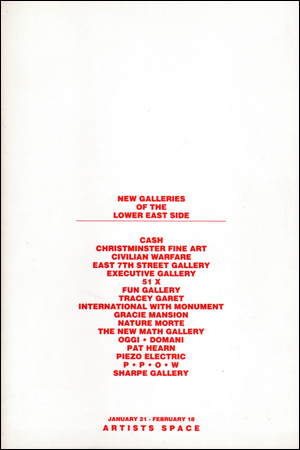
Exhibition brochure / catalogue published in conjunction with show held January 21 - February 18, 1984. Foreword by Linda Shearer. Curated and with a text by Helene Winer. Galleries include Cash, Christminster Fine Art, Civilian Warfare, East 7th Street Gallery, Executive Gallery, 51 X, Fun Gallery, Tracey Garet, International With Monument, Gracie Mansion, Nature Morte, The New Math Gallery, Oggi - Domani, Pat Hearn, Piezo Electric, PPOW, and Sharpe Gallery. Artists include Stephen Aljian, Alan Belcher, Paul Benney, Zeke Berman, Ellen Berkenblit, Keiko Bonk, Tom Brazelton, Barry Bridgwood, Nancy Brooks Brody, Chris Chevins, Craig Coleman, Rich Colicchio, Michael Collins, George Condo, Gregory A. Crane, Mark Dean, Jimmy de Sana, Futura, Robert Garratt, Dana Garrett, Judith Glantzman, Arthur Gonzalez, Rodney Alan Greenblat, Kathleen Grove, Richard Hambleton, Kiely Jenkins, Sermin Kardestuncer, Elizabeth Koury, Stephen Lack, Leora Laor, Robert Loughlin, Paul Marcus, Frank Moore, Peter Nagy, Michael Ottersen, Steven Parrino, Rick Prol, Hope Sandrow, Michael Sangaris, Bruno Schmidt, Peter Schuyff, Huck Snyder, Ahbe Sulit, Frederick Sutherland, Meyer Vaisman, Oliver Wasow, Dondi White, David Wojnarowicz, Robert Yarber, Zephyr, and Rhonda Zwillinger.
The exhibition includes work from seventeen galleries located in the East Village or the area east of Second Avenue, just below Houston Street: CASH, Christminster, Civilian Warfare, East 7th Street Gallery. Executive Gallery, 51 X, Fun Gallery, Garet/ Kohn Gallery, Gracie Mansion. International with Monument, Nature Morte, New Math, Oggi-Domani, Pat Hearn. Piezo Electric, P.P.O.W. and Sharpe Gallery. Work by artists associated with the galleries have been selected by the individual gallery directors, and Helene Winer, organizer of the exhibition.
Helene Winer is a past Director of Artists Space and currently co-owner of Metro Pictures a commercial gallery in SoHo. As part of Artists Space''s celebration of its 10th anniversary season, she has organized this exhibition to examine a growing number of artist organized commercial exhibition spaces. Ms. Winer''s past experience with the non-profit art community and her present position in the commercial art world offer a unique outlook on this new trend. In keeping with Artists Space''s support of new art through both its Exhibition Program and Grants Program, NEW GALLERIES OF THE LOWER EAST SIDE is a look at a new outlet for emerging art: an outlet which straddles the lines between the artists cooperative, the non-profit alternative space, the artist organized independent exhibition and the commercial gallery.
NEW GALLERIES OF THE LOWER EAST SIDE acknowledges the recent appearance and rapid proliferation of more than twenty commercial art galleries that are introducing new artists and art. This phenomenon has created overnight, it seems, active new exhibition outlets for artists, an on-going vehicle for massive social opening events, a Sunday activity for the art audience, a new map in the Gallery Guide and a new focus of excitement and energy in the art community.
The galleries are now numerous and offer more than the aesthetic that was first presented by the pioneers (Gacie Mansion, Fun Gallery and 51 X) and which has come to be associated with the East Village. They are very professional enterprises that intend to provide serious support and attention to the artists they show. Many of the galleries are artist owned. The artist/owners who converted storefronts to studios have now converted these studios to galleries. Most of these owners work at jobs separate from the gallery to support the activity and many live ''behind the shop." The East Village Eye and New York Beat play the role that the SoHo News and the Village Voice did for SoHo and Tribeca. The East Village and the Lower East Side of New York has been an area many artists moved to, since SoHo and then Tribeca have been increasingly gentrified, a fate that may now befall the East Village itself.
Over the years the art community has found ''alternative'' means of creating needed opportunities for artists to exhibit their work to at least their peers, and occasionally to a broader audience. In the fifties. New York artists opened cooperative galleries on Tenth Street. Later, alternative spaces opened with government funding: commercial galleries moved from Uptown to Downtown for both space and accessibility to the artists community; artists organized their own temporary exhibitions such as the Times Square Show, and now, in a period of two years, some 25 commercial galleries have opened on the Lower East Side, the majority in 1983.—from exhibition press release